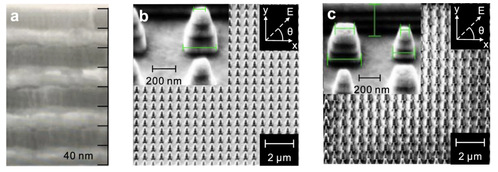Recently, Professor Sailing He, Professor of Zhejiang University and Adjunct Professor of Shanghai Institute for Advanced Study of Zhejiang University (SIAS), and his collaborators have made progress in studying broadband amplified second harmonic generation from hyperbolic dispersive metamaterials. The work exploits the property that trapezoidal hyperbolic dispersive metamaterials with gradual width can achieve localized electromagnetic field enhancement (rainbow capture effect) in a wide frequency range to achieve full-color enhanced second harmonic generation, and has published as ‘Full-color enhanced second harmonic generation using rainbow trapping in ultrathin hyperbolic metamaterials in Nature Communications.
Nonlinear optics describes nonlinear relationship between the incident field and resulting polarization of the corresponding field in the interaction between light and matter. As one of the most fundamental branches of optical physics, nonlinear optics enjoys wide implications in laser technology, microscopic imaging, materials science, biological imaging, and quantum optics etc.
Nonlinear effects arise from higher order terms in the polarization of electromagnetic fields under excitation fields. Their response is usually weak and requires stringent phase-matching or quasi-phase-matching conditions and sufficient length to amplify the nonlinear effects, resulting in nonlinear devices that are often bulky and difficult to integrate.
While hypersurfaces can enhance light-matter interactions in subwavelength nanostructures and thus improve nonlinearity, these hypersurfaces typically rely on resonance with high quality factors for field enhancement, and they are narrowband in principle, limiting application to broadband nonlinearity.

Hyperbolic metamaterial waveguide cells, whose sidewalls support surface wave transmission and where the group velocity of the surface wave mode approaches zero as the optical frequency approaches the mode's cutoff frequency, generate slow light and greatly enhance optical field localization. Trapezoidal hyperbolic dispersive metamaterials with different widths corresponding to different cutoff frequencies enable the enhancement of the local electromagnetic field over a wide frequency range (rainbow capture effect).

The research team has constructed an ultrathin trapezoidal hyperbolic dispersive metamaterial based on a gold/zinc oxide multilayer structure that achieves enhanced second harmonic generation in the visible range (400-650 nm), an electromagnetic field gain factor at the fundamental frequency of more than 50 in the wavelength range of 470-650 nm, and a maximum multiplicative conversion efficiency of 1.13×10−6 at 8.80 mW pump power. This study provides an efficient and reliable implementation method for broadband nonlinear super-surface devices.

To access the article, please visit https://www.nature.com/articles/s41467-021-26818-3. Dr Lin Chen and Dr Wei Xiong from Huazhong University of Science and Technology, as well as Dr Qing Zhang from Peking University are the corresponding authors for the article, and Dr Sailing He has contributed to the work as well.
About Professor Sailing He
Professor Sailing is a Fellow of IEEE, OSA (Optical Society of America) and SPIE (International Society for Optical Engineering), and he is currently the Director for the Sino-Swedish Joint Research Center of Photonics (JORCEP) and an Adjunct Professor of Shanghai Institute for Advanced Study of Zhejiang University (SIAS). After receiving his Ph.D. degree from the Royal Institute of Technology, he has worked at the Royal Institute of Technology (Stockholm, Sweden) as an assistant professor, an associate professor, and a full professor.
Professor He’s main research interest includes sub-wave length photonics, optical sensing and communication, electromagnetic waves and applications.
He has first-authored one monograph(Oxford University Press) and authored/co-authored over 700 papers in refereed international journals. Prof. He has served as General Chair (or Co-chair) for a number of international conferences, as well as in Steering Committee, Scientific Advisory Board or Technical Program Committee for numerous international congress/conferences and journals. Prof. He serves as co-editor-in-chief of Progress In Electromagnetics Research (PIER), in editorial board of Laser& Photonics Reviews, Scientific Reports, and Electronics Letters.
About SIAS
Shanghai Institute for Advanced Study of Zhejiang University (SIAS) is a jointly launched new institution of research and development by Shanghai Municipal Government and Zhejiang University in June, 2020. The platform represents an intersection of technology and economic development, serving as a market leading trail blazer to cultivate a novel community for innovation amongst enterprises.
SIAS is seeking top talents working on the frontiers of computational sciences who can envision and actualize a research program that will bring out new solutions to areas include, but not limited to, Artificial Intelligence, Computational Biology, Computational Engineering and Fintech.

